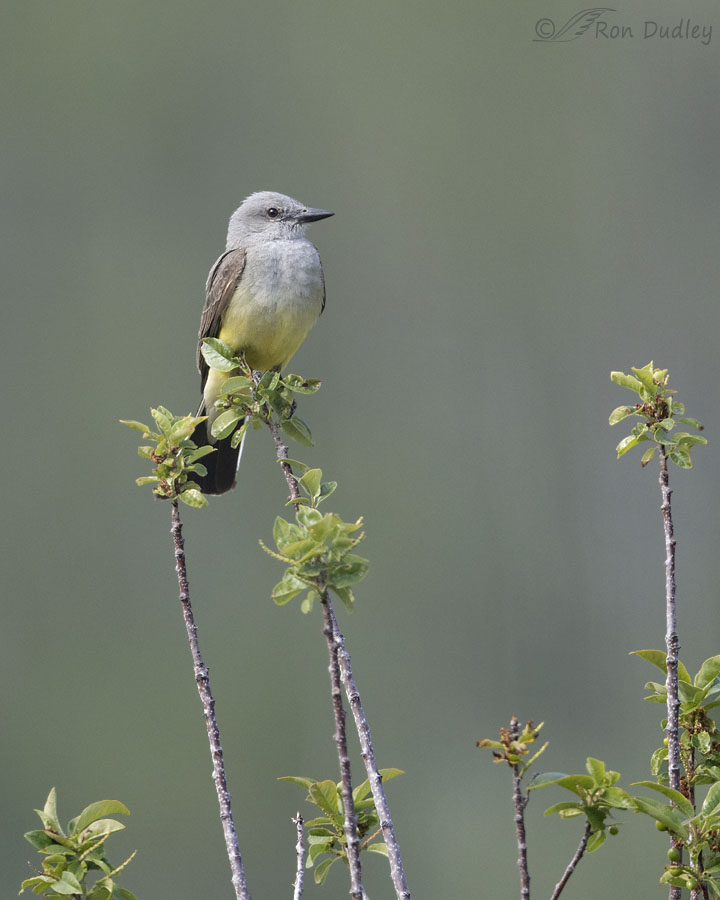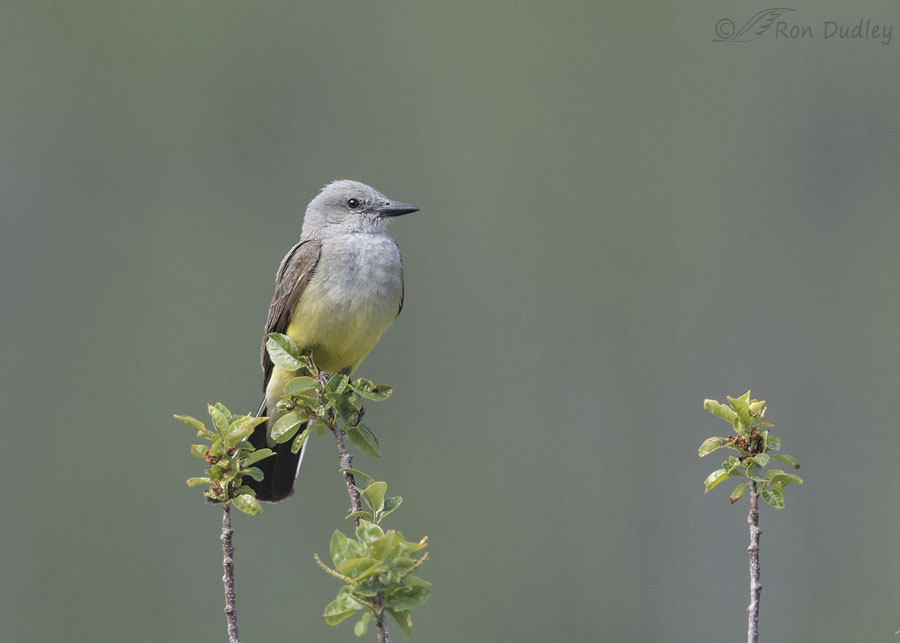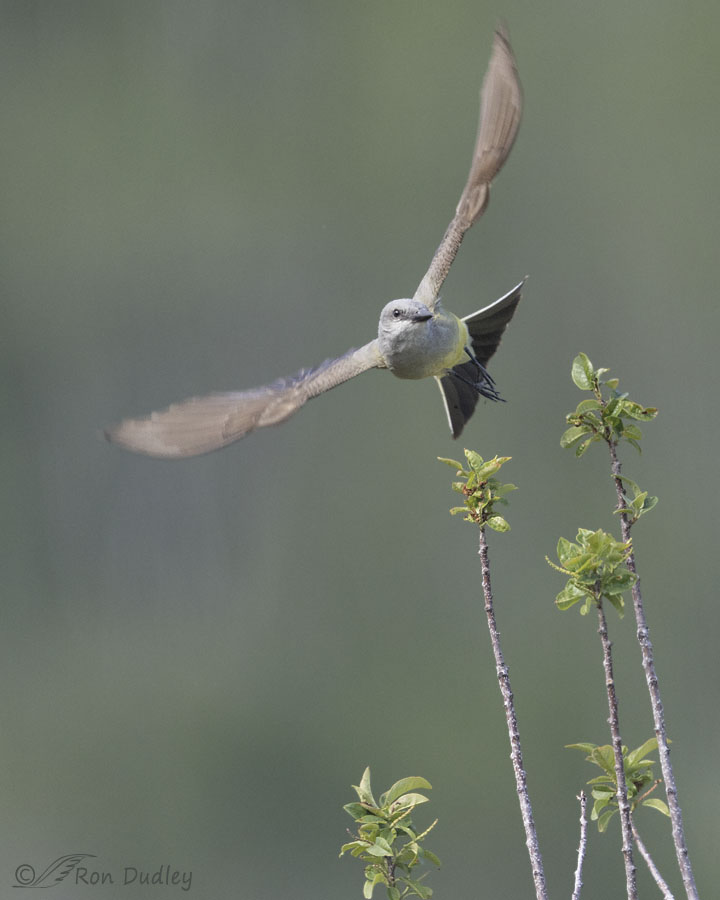Directional light can be a double-edged sword.

1/1600, f/5.6, ISO, 1600, Canon R5, Canon EF500mm f/4L IS II USM + 1.4 tc, not baited, set up or called in
Two days ago, on a mostly sunny morning in the mountains, I spotted this Western Kingbird perched on the “wrong” side of the dirt road in front of me. ‘He’ was strongly side lit but I decided to try for the shot anyway, which required some pretty creative driving and parking to allow me to photograph him from my driver’s side window.
As I was inching toward him and getting the angle I needed, the sun very suddenly went behind a dark cloud which tamed the directional light and provided much more even light to the entire scene. The result was this photo and a few others like it that I’m sure I like a lot more than I would have if the bird had been strongly side lit.

An alternate composition of the same image, if you prefer. Personally I don’t, even though the bird is a little larger in the frame.
But subdued light cuts both ways. When I lost the bright directional light I also lost most of my shutter speed, even though I’d cranked up my ISO to 1600.
The result?

1/2000, f/5.6, ISO, 1600, Canon R5, Canon EF500mm f/4L IS II USM + 1.4 tc, not baited, set up or called in
Two potentially very interesting takeoff and flight shots that were just a little too soft to be useable for anything except as examples of action shots taken with a shutter speed that was too slow for the situation.
Yes, especially with the R5 I could have dialed up my ISO even more to give me plenty of SS.
Woulda, coulda, shoulda – you know the drill. Next time…
Ron


Your experience mirrors that of birds of prey. How many times do they get an opportunity for a petit dejeuner, then stoop at breakneck speed to find their talons grasping at tufts of grass or vacant bouncing twigs? I’m so glad you persist despite the odds: you offer us a view of the natural world we seldom see for ourselves! Thanks!
Much appreciated, Elise.
Love the first (vertical) image! I know you’re shooting from far away, but I always marvel that your intended targets generally stay in place long enough for you to get the shot, even after having to rearrange your vehicle, your equipment, your camera settings, etc. All I have to do is *think* about lifting my binocs or a camera and they magically disappear!
“your intended targets generally stay in place long enough for you to get the shot”
Ha, you think that because you only see the shots I get. I’d say that 70 – 80% of the time the bird flies off before I even get my pickup stopped, much less get them in my viewfinder.
I learned most of my go-to cuss words growing up on a Montana farm but I never wore them out until I became a bird photographer.
Definitely the vertical shot.
The woulda/coulda/shoulda (and particularly the last) is something I whip myself with often. Sigh.
EC, with bird photography it comes with the territory. Daily.
One reference has it that “Tyrannus” is Greek for lord, as in “The genus lords it over the flying insects and takes them in flight at will.” The original “Lord of the Flies”.
Personally, I prefer your “benevolent kings” descriptor; regal and distinguished looking.
“The original “Lord of the Flies””
Loved that, Lyle. Perfect.
Great shots! I like the light on the bird. I missed the kingbird. Yes, it was a woulda coulda shoulda morning that day. Had the same reaction when I got home and viewed the hummingbird shots.
April, at least we have the opportunity to learn from these kinds of situations. Not that we always do…
Thanks for sharing. Appreciate the lesson.
Good. Thanks, Michael.
I really admired the first shot– mainly for the clear look at the “sunny”
coloring on the bird’s ventral side– and the upward thrust of the long stems
and their yellow-green hue provide a link with a harmonious hue to that of the bird’s belly……
Thank you, Kris.
Gorgeous and I like the first one better.
Thanks, Jo.
Much of our lives are filled with woulda, coulda, shoulda. So often after taking a shot or shots of whatever bird or wildlife I am working on I start thinking of what I did not do that I could have done, but didn’t. Guess that sometimes happens even with the best of the professionals.
Anyway, these are really nice shots. Like the lighting and colors etc.
With me it happens a lot, Everett.
And with birds it’s all complicated by the risky decision – Do I take the time to change the camera setting and risk the bird taking off while I’m doing it? Choices…
Lovely shots, all. Love the first for all the reasons given. And I like the last tremendously, as well. Lovely take-off angle
Thanks very much, Sallie.
Love the vertical composition because of the stems. They give him a look of being at the top of a tower.
Thanks, Mary. That’s why I prefer the vertical too.
Challenge met! Glad he held still for you…. I prefer #1 personally. While the wings ARE blurred it does show the motion well.
I prefer #1 personally. While the wings ARE blurred it does show the motion well. 
REALLY quiet here bird wise with the Grackles and Magpies gone. OK in one way tho as I could hear the wrens notifying me of a buzztail a couple of days back…… #4 in the yard so far…..
#4 in the yard so far…..
Judy, I’m seeing a lot of reports of unusually large numbers of snakes this summer, of many species and in different parts of the country.
Suspect extreme weather (fire/floods) is driving some of it. For us it’s mainly a matter of being somewhat early this year. Numbers fluctuate from year to year tho this is pushing it a bit for buzztails……
The bird looks superbly “kingly” in all your shots. I liked the vertical format in the first one as it appears master of its “kingdom.”
“The bird looks superbly “kingly” in all your shots”
Yes, their genus name is Tyrannus and for good reason. There aren’t many benevolent kings that I know of.